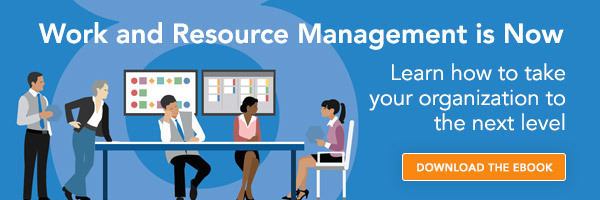
To close up this blog series based on the Ventana Research whitepaper, “Five Ways to Increase Efficiency and Innovate Faster,” I will cover how you can get started with work and resource management. Before I get into how you can minimize any complexity around adopting a new system, make sure you’re caught up on the previous five blogs, listed below:
- What is Work and Resource Management: Part 1 – Adapting to change;
- Overcome Hurdles to Maximize Business Value: Part 2 – Advance the business with work and resource management;
- Assess the Current State of Your Organization: Part 3 – Review processes, take an inventory, align work and resources;
- Advantages of Work and Resource Management Applications: Part 4 – All for one and one for all; and
- Work and Resource Management: Benefits to Bypass the Competition: Part 5 – Boost Your Organization with the Benefits of WRM.
It’s an unfortunate reality that most organizations are apt to postpone priorities or investments that seem to be complex—work and resource management may fall under this category for some. However, it is something that simply cannot be ignored. Organizations must step up to the plate and kick start the process of improving work and resource management, and I’ll let you in on a secret…
It’s easier to achieve than you think.
Just follow 5 simple steps and you’ll be on your way to minimizing costs and maximizing efficiency and
effectiveness of your work and resources. Let’s walk through each one, together.
Step 1: “Assess all the ways your organization currently manages work and resources.”
This means looking into document storage, spreadsheets, disparate systems, etc. Determine which processes are used most often and how each department goes about allocating resources.
Step 2: “Identify inefficiencies in your current formal and informal planning approaches and prioritize the challenges.”
If you have trouble spotting specific inefficiencies, walk through a fictitious planning scenario from start to finish. Suddenly, you’ll find weak points that take too much time or effort become much more visible.
Step 3: “Quantify the value that will be realized from eliminating the inefficiencies and the value of improvement to the organization.”
Once you’ve determined those weak points, imagine what work would be like if they were eliminated. Think about the time, money, and effort that will be saved, and multiply that value across the entire organization.
Step 4: “Evaluate choices for technological approaches to streamlining work processes that can meet both today’s challenges and needs for the future.”
You’ve realized the benefits of efficient work and resource management outweigh any learning curve in adopting new processes. Now, map out your options for updated technological approaches and pick the one best suited for your organization. Also, ensure it can adapt to changes in the future.
Step 5: “Identify ways to maximize the potential of work and resources through unified processes and applications that use common data and analytics.”
The new system has been selected and implemented, now it’s time for the fun part—you get to witness the results. Suddenly, you’ll find there is improved allocation of work and resources, better work collaboration, and more efficient employees.
As stated in the Ventana Research whitepaper, “once you understand the technology and applications available and assess your organization’s capabilities, you’ll be able to minimize complexity and increase efficiency to be able to innovate faster.” For more information on work and resource management and how you can improve your organization’s processes, visit Planview.com to learn how Planview can help you get started with the right solution.





